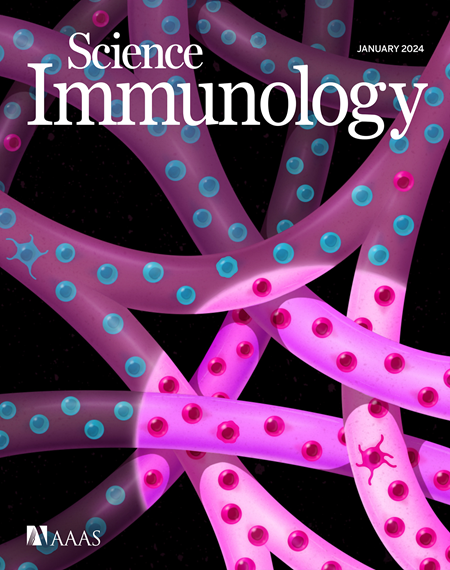啮齿类动物和人类PD-1的功能差异与进化分化有关
IF 17.6
1区 医学
Q1 IMMUNOLOGY
引用次数: 0
摘要
对抑制性免疫受体PD-1的机制理解主要基于小鼠模型,但人和小鼠PD-1只有59.6%的氨基酸相同。在这里,我们发现人类PD-1比小鼠PD-1具有更强的抑制作用,这是因为人类PD-1与配体PD-L1和PD-L2的相互作用更强,并且更有效地募集了效应磷酸酶Shp2。在过继性转移T细胞的小鼠黑色素瘤模型中,PD-1细胞内结构域的人源化破坏了CD8 + T细胞的抗肿瘤活性,并增加了抗PD-1反应的强度。我们发现了一个在脊椎动物PD-1同源体中高度保守的基序,在啮齿动物中不存在,这是差异Shp2募集的关键决定因素。进化分析表明,PD-1在进化过程中经历了啮齿动物谱系特异性的功能衰减。总之,我们的研究揭示了PD-1通路的物种特异性特征,对PD-1进化和小鼠模型和人类患者的不同抗pd -(L)1反应具有重要意义。本文章由计算机程序翻译,如有差异,请以英文原文为准。
Functional differences between rodent and human PD-1 linked to evolutionary divergence
Mechanistic understanding of the inhibitory immunoreceptor PD-1 is largely based on mouse models, but human and mouse PD-1 share only 59.6% amino acid identity. Here, we found that human PD-1 is more inhibitory than mouse PD-1, owing to stronger interactions with the ligands PD-L1 and PD-L2 and more efficient recruitment of the effector phosphatase Shp2. In a mouse melanoma model with adoptively transferred T cells, humanization of a PD-1 intracellular domain disrupted the antitumor activity of CD8+ T cells and increased the magnitude of anti–PD-1 response. We identified a motif highly conserved across vertebrate PD-1 orthologs, absent in rodents, as a key determinant for differential Shp2 recruitment. Evolutionary analysis suggested that PD-1 underwent a rodent lineage–specific functional attenuation during evolution. Together, our study uncovers species-specific features of the PD-1 pathway, with implications for PD-1 evolution and differential anti–PD-(L)1 responses in mouse models and human patients.
求助全文
通过发布文献求助,成功后即可免费获取论文全文。
去求助
来源期刊

Science Immunology
Immunology and Microbiology-Immunology
CiteScore
32.90
自引率
2.00%
发文量
183
期刊介绍:
Science Immunology is a peer-reviewed journal that publishes original research articles in the field of immunology. The journal encourages the submission of research findings from all areas of immunology, including studies on innate and adaptive immunity, immune cell development and differentiation, immunogenomics, systems immunology, structural immunology, antigen presentation, immunometabolism, and mucosal immunology. Additionally, the journal covers research on immune contributions to health and disease, such as host defense, inflammation, cancer immunology, autoimmunity, allergy, transplantation, and immunodeficiency. Science Immunology maintains the same high-quality standard as other journals in the Science family and aims to facilitate understanding of the immune system by showcasing innovative advances in immunology research from all organisms and model systems, including humans.
 求助内容:
求助内容: 应助结果提醒方式:
应助结果提醒方式:


